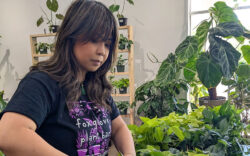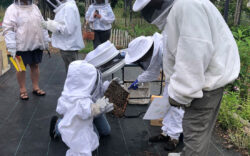Although a clever acronym, G.O.A.T. denotes an undisputed greatness—something that the polarizing cloven-hoofed rascals do not own. Even goat owners like me are more likely to tell tales of vexing pranksters than placid, perfect plant-eaters. Goats require more attention than many other farm animals because of their attitudes, health and unwavering desire to escape any fencing.
My partner, Jacob, and I decided to get goats in 2021. We wanted to add another animal to our three-dog-and-chicken-flock household, and goats seemed like a good fit for us. They could help manage weeds, provide excellent manure for compost and might, eventually, provide us with milk and baby goats (also known as kids). I worked on a cheese-making Vermont farm one summer and loved the idea of creating udder-to-plate cheeses in my home.
I found Avalon and Valhalla, shortened to Ava and Val, through various goat-keeping groups on Facebook. They were perfect: Sweet little girls, curious about the world, nibbling on boots, shirts, leaves and grass indiscriminately. Ava climbed Jacob’s shoulders, and I held Val. I snuggled her soft, hay-smelling neck against my face. Ava and Val are LaManchas, a breed known for their tiny belly-button ears, quality milk and friendliness.
We brought them home in the backseat of my Yaris. Ava rested her head on the emergency brake and fell asleep after demanding Jacob rub her neck constantly on the drive home. Val paced in the back, staring out the window with a dog-like intensity.
Jacob and I soon learned our new goats wanted things (like neck rubs) a certain way. And when they didn’t get it, they cried. Was dinner 10 minutes late? Crying. Was I nearby and not petting them? Crying. Did they spy me in a window and then I didn’t come outside? Crying. Loud, sad, baying with tongues out at a volume that made me hope our neighbors couldn’t hear the commotion I heard from my bedroom. Were they crying because they wanted more food? Different food? More attention? Was their shelter too dark? Too big? Not big enough?
Thankfully, Oglethorpe County extension agent Shanna Reynolds helped assuage my fears. She came for a site visit, showed me how to clip a goat’s hooves (there’s a learning curve I’m still climbing two years later), checked for parasites and gave suggestions on food, bedding and shelter. When I mentioned all the crying, she told me dryly that goats are drama queens, and running to check on their every bay and bray was reinforcing the behavior. Val and Ava don’t cry as much any more, and with experience, I’ve learned to tell the, “It’s raining on me!” cry from the, “Where’s my dinner?” cry and the, “Come pet me, right now!” cry.
I’ve also learned about living with the Houdini of farm animals. There’s this unattributed adage in one of my goat reference books: “A fence that can hold water, can hold a goat.” Goats escape. Not all the time, but consistently. Ava mostly jumps over the fence. Smaller and more athletic, she clears barriers that Val trips and clotheslines on, her big tummy pooling on the pallet or stump she’s attempted. Val is much smarter, learning how to flip latches, pull one-way doors and slide under unsecured fencing. Ava is left mimicking Val’s actions, but unsure about where to apply pressure on the fence, latch or door, if not left open. Once, I ran to stop goats gobbling whole branches of a defenseless Japanese maple. Now, I walk to rescue the tree, and give it more compost than its fellows.
Oglethorpe County, of course, is rural, so check your local zoning laws if, after reading, you’re still convinced goats are for you. In Athens-Clarke County, goats are considered livestock and can only be raised in areas zoned agricultural, unlike backyard chickens. This mainly means the far east side of town where houses are on at least 10-acre lots.
Two years into this goat experiment, and I feel a bucolic atmosphere on the farm I didn’t before. I walk Val and Ava on leashes around the property, pointing out tasty patches of poison ivy or chain-y briar for a pre-dinner snack. The meandering manure slowly improves the soil in a sort of compost-as-you-go method. Every pile of logs, picnic table or slight soil mound becomes a climbable mountain they must surmount and, first, defend from dogs and then each other. It’s a lovely way to spend an afternoon, even as Val makes off with a few mouthfuls of blooming blueberry branches.
This year, I plan on launching a new goat experiment: Kids. Pen renovations are on the horizon, as is a new learning curve with a DIY insemination kit. I’m not sure how this new phase of goat ownership will go, but I suspect that if I pay attention, they’ll let me know. Loudly.
Like what you just read? Support Flagpole by making a donation today. Every dollar you give helps fund our ongoing mission to provide Athens with quality, independent journalism.










